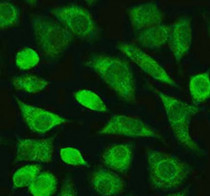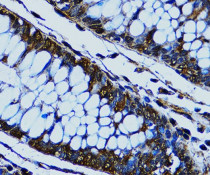ARG42033
anti-EGLN1 + EGLN2 antibody
anti-EGLN1 + EGLN2 antibody for ICC/IF,IHC-Formalin-fixed paraffin-embedded sections,Western blot and Human,Mouse,Rat
概述
| 产品描述 | Rabbit Polyclonal antibody recognizes EGLN1 + EGLN2 |
|---|---|
| 反应物种 | Hu, Ms, Rat |
| 应用 | ICC/IF, IHC-P, WB |
| 宿主 | Rabbit |
| 克隆 | Polyclonal |
| 同位型 | IgG |
| 靶点名称 | EGLN1 + EGLN2 |
| 抗原物种 | Human |
| 抗原 | Recombinant fusion protein corresponding to aa. 1-426 of Human EGLN1 (NP_071334.1). |
| 偶联标记 | Un-conjugated |
| 別名 | EGLN1: HPH-2; HIF-PH2; Egl nine homolog 1; HIF-prolyl hydroxylase 2; HPH2; ZMYND6; C1orf12; HALAH; PHD2; Prolyl hydroxylase domain-containing protein 2; Hypoxia-inducible factor prolyl hydroxylase 2; SM-20; HIFPH2; EC 1.14.11.29; SM20; ECYT3 EGLN2: EIT6; PHD1; EIT-6; HPH-1; HPH-3; HIFPH1; HIF-PH1 |
应用说明
| 应用建议 |
|
||||||||
|---|---|---|---|---|---|---|---|---|---|
| 应用说明 | * The dilutions indicate recommended starting dilutions and the optimal dilutions or concentrations should be determined by the scientist. | ||||||||
| 阳性对照 | Rat heart | ||||||||
| 实际分子量 | ~ 46 kDa |
属性
| 形式 | Liquid |
|---|---|
| 纯化 | Affinity purified. |
| 缓冲液 | PBS (pH 7.3), 0.02% Sodium azide and 50% Glycerol. |
| 抗菌剂 | 0.02% Sodium azide |
| 稳定剂 | 50% Glycerol |
| 存放说明 | For continuous use, store undiluted antibody at 2-8°C for up to a week. For long-term storage, aliquot and store at -20°C. Storage in frost free freezers is not recommended. Avoid repeated freeze/thaw cycles. Suggest spin the vial prior to opening. The antibody solution should be gently mixed before use. |
| 注意事项 | For laboratory research only, not for drug, diagnostic or other use. |
生物信息
| 基因名称 | EGLN1; EGLN2 |
|---|---|
| 全名 | egl-9 family hypoxia-inducible factor 1 egl-9 family hypoxia inducible factor 2 |
| 背景介绍 | EGLN1: The protein encoded by this gene catalyzes the post-translational formation of 4-hydroxyproline in hypoxia-inducible factor (HIF) alpha proteins. HIF is a transcriptional complex that plays a central role in mammalian oxygen homeostasis. This protein functions as a cellular oxygen sensor, and under normal oxygen concentration, modification by prolyl hydroxylation is a key regulatory event that targets HIF subunits for proteasomal destruction via the von Hippel-Lindau ubiquitylation complex. Mutations in this gene are associated with erythrocytosis familial type 3 (ECYT3). [provided by RefSeq, Nov 2009] EGLN2: The hypoxia inducible factor (HIF) is a transcriptional complex that is involved in oxygen homeostasis. At normal oxygen levels, the alpha subunit of HIF is targeted for degration by prolyl hydroxylation. This gene encodes an enzyme responsible for this post-translational modification. Alternative splicing results in multiple transcript variants. Read-through transcription also exists between this gene and the upstream RAB4B (RAB4B, member RAS oncogene family) gene. [provided by RefSeq, Feb 2011] |
| 生物功能 | EGLN1: Cellular oxygen sensor that catalyzes, under normoxic conditions, the post-translational formation of 4-hydroxyproline in hypoxia-inducible factor (HIF) alpha proteins. Hydroxylates a specific proline found in each of the oxygen-dependent degradation (ODD) domains (N-terminal, NODD, and C-terminal, CODD) of HIF1A. Also hydroxylates HIF2A. Has a preference for the CODD site for both HIF1A and HIF1B. Hydroxylated HIFs are then targeted for proteasomal degradation via the von Hippel-Lindau ubiquitination complex. Under hypoxic conditions, the hydroxylation reaction is attenuated allowing HIFs to escape degradation resulting in their translocation to the nucleus, heterodimerization with HIF1B, and increased expression of hypoxy-inducible genes. EGLN1 is the most important isozyme under normoxia and, through regulating the stability of HIF1, involved in various hypoxia-influenced processes such as angiogenesis in retinal and cardiac functionality. Target proteins are preferentially recognized via a LXXLAP motif. [UniProt] EGLN2: Cellular oxygen sensor that catalyzes, under normoxic conditions, the post-translational formation of 4-hydroxyproline in hypoxia-inducible factor (HIF) alpha proteins. Hydroxylates a specific proline found in each of the oxygen-dependent degradation (ODD) domains (N-terminal, NODD, and C-terminal, CODD) of HIF1A. Also hydroxylates HIF2A. Has a preference for the CODD site for both HIF1A and HIF2A. Hydroxylated HIFs are then targeted for proteasomal degradation via the von Hippel-Lindau ubiquitination complex. Under hypoxic conditions, the hydroxylation reaction is attenuated allowing HIFs to escape degradation resulting in their translocation to the nucleus, heterodimerization with HIF1B, and increased expression of hypoxy-inducible genes. EGLN2 is involved in regulating hypoxia tolerance and apoptosis in cardiac and skeletal muscle. Also regulates susceptibility to normoxic oxidative neuronal death. Links oxygen sensing to cell cycle and primary cilia formation by hydroxylating the critical centrosome component CEP192 which promotes its ubiquitination and subsequent proteasomal degradation. Hydroxylates IKBKB, mediating NF-kappaB activation in hypoxic conditions. Target proteins are preferentially recognized via a LXXLAP motif. |
| 细胞定位 | EGLN1: Cytoplasm. Nucleus. Note=Mainly cytoplasmic. Shuttles between the nucleus and cytoplasm (PubMed:19631610). Nuclear export requires functional XPO1. [UniProt] EGLN2: Nucleus. [UniProt] |
| 预测分子量 | 46 kDa |
| 翻译后修饰 | EGLN1: S-nitrosylation inhibits the enzyme activity up to 60% under aerobic conditions. Chelation of Fe(2+) has no effect on the S-nitrosylation. It is uncertain whether nitrosylation occurs on Cys-323 or Cys-326. [UniProt] |
检测图片 (3) Click the Picture to Zoom In
-
ARG42033 anti-EGLN1 + EGLN2 antibody ICC/IF image
Immunofluorescence: L929 cells stained with ARG42033 anti-EGLN1 + EGLN2 antibody at 1:100 dilution. DAPI (blue) for nuclear staining.
-
ARG42033 anti-EGLN1 + EGLN2 antibody IHC-P image
Immunohistochemistry: Paraffin-embedded Human colon tissue stained with ARG42033 anti-EGLN1 + EGLN2 antibody at 1:100 dilution.
-
ARG42033 anti-EGLN1 + EGLN2 antibody WB image
Western blot: 25 µg of Rat heart lysate stained with ARG42033 anti-EGLN1 + EGLN2 antibody at 1:3000 dilution.








